Corporate and Financial Accounting
VerifiedAdded on 2023/03/30
|11
|2594
|404
AI Summary
This study evaluates business combinations, acquisition methods, corporate groups, non-controlling interests, and intragroup transactions in corporate and financial accounting. It covers the differences between consolidation accounting and equity accounting, treatment of intra-group transactions, and the impact of NCI disclosure requirements.
Contribute Materials
Your contribution can guide someone’s learning journey. Share your
documents today.

Corporate and Financial Accounting
Secure Best Marks with AI Grader
Need help grading? Try our AI Grader for instant feedback on your assignments.
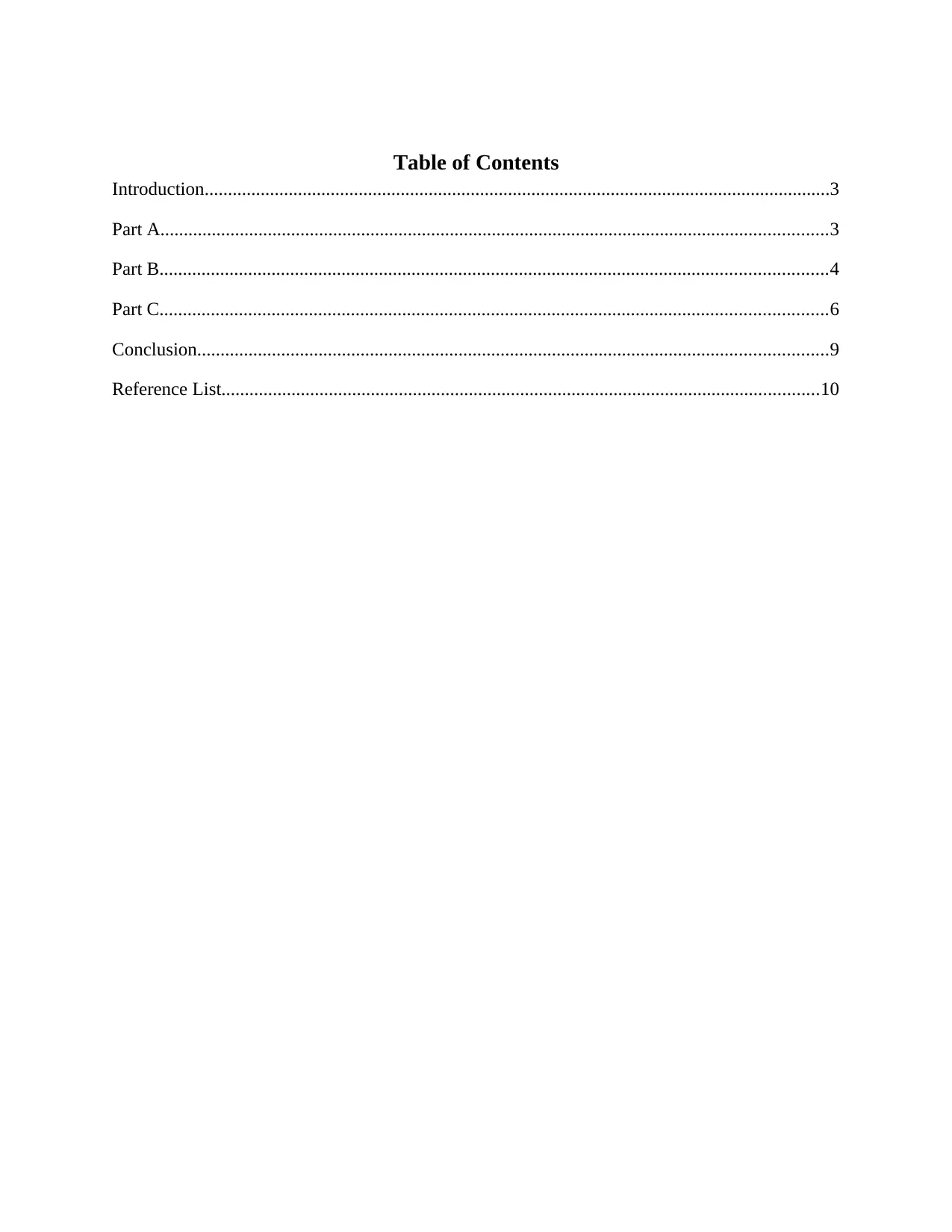
Table of Contents
Introduction......................................................................................................................................3
Part A...............................................................................................................................................3
Part B...............................................................................................................................................4
Part C...............................................................................................................................................6
Conclusion.......................................................................................................................................9
Reference List................................................................................................................................10
Introduction......................................................................................................................................3
Part A...............................................................................................................................................3
Part B...............................................................................................................................................4
Part C...............................................................................................................................................6
Conclusion.......................................................................................................................................9
Reference List................................................................................................................................10

INTRODUCTION
The present study aims to evaluate and interpret business combinations, acquisition methods, the
corporate group, non-controlling interests (NCI) and intragroup transactions with the help of
independent and comprehensive research supported by a relevant accounting standard. The
present study covers the key differences in methodology between Consolidation Accounting and
Equity Accounting, treatment of intra-group transactions. The prevailing piece of paper also
emphasizes on the changes required to ensure the correct statement of consolidated financial
statements and their impact on the disclosure requirements in the annual report, while
considering the impacts of NCI disclosure requirement as a separate item in the consolidation
process.
PART A
The equity method is considered as an accounting method, in which investments are recognized
initially at costs and thereafter adjustments is done for the post-acquisition change in the share of
investor of the net assets of investee. Further, the profit or loss of the investor comprises its share
of the profit or loss of the investee and other comprehensive income of the investor, including its
share of the other comprehensive income of the investee(Schwarzbichler, Steiner & Turnheim,
2018). Due to the fact that, investor possess significant influence or joint control on the investee,
in this way investor gains the interest in the performance of joint venture and consequently on
the return on investments. Thus, using the equity method offers better informative and useful
reporting of the net assets, P&L of the investor.
On the other hand, the consolidation method is an investment accounting that is employed for the
consolidation of financial statements of most of the ownership investments. This is applied when
the investor has better control of the subsidiary which generally, however no every time, makes
assumption that the investor has the ownership of approx 50.1% of the shares or subsidiary. This
method of consolidation operates by doing report of balances of subsidiary in a combined
statement, together with the balances of parent company, thus stated as consolidated. As per the
consolidation method, the parent company would be combining its individual revenue with
100% subsidiary revenue.
The present study aims to evaluate and interpret business combinations, acquisition methods, the
corporate group, non-controlling interests (NCI) and intragroup transactions with the help of
independent and comprehensive research supported by a relevant accounting standard. The
present study covers the key differences in methodology between Consolidation Accounting and
Equity Accounting, treatment of intra-group transactions. The prevailing piece of paper also
emphasizes on the changes required to ensure the correct statement of consolidated financial
statements and their impact on the disclosure requirements in the annual report, while
considering the impacts of NCI disclosure requirement as a separate item in the consolidation
process.
PART A
The equity method is considered as an accounting method, in which investments are recognized
initially at costs and thereafter adjustments is done for the post-acquisition change in the share of
investor of the net assets of investee. Further, the profit or loss of the investor comprises its share
of the profit or loss of the investee and other comprehensive income of the investor, including its
share of the other comprehensive income of the investee(Schwarzbichler, Steiner & Turnheim,
2018). Due to the fact that, investor possess significant influence or joint control on the investee,
in this way investor gains the interest in the performance of joint venture and consequently on
the return on investments. Thus, using the equity method offers better informative and useful
reporting of the net assets, P&L of the investor.
On the other hand, the consolidation method is an investment accounting that is employed for the
consolidation of financial statements of most of the ownership investments. This is applied when
the investor has better control of the subsidiary which generally, however no every time, makes
assumption that the investor has the ownership of approx 50.1% of the shares or subsidiary. This
method of consolidation operates by doing report of balances of subsidiary in a combined
statement, together with the balances of parent company, thus stated as consolidated. As per the
consolidation method, the parent company would be combining its individual revenue with
100% subsidiary revenue.
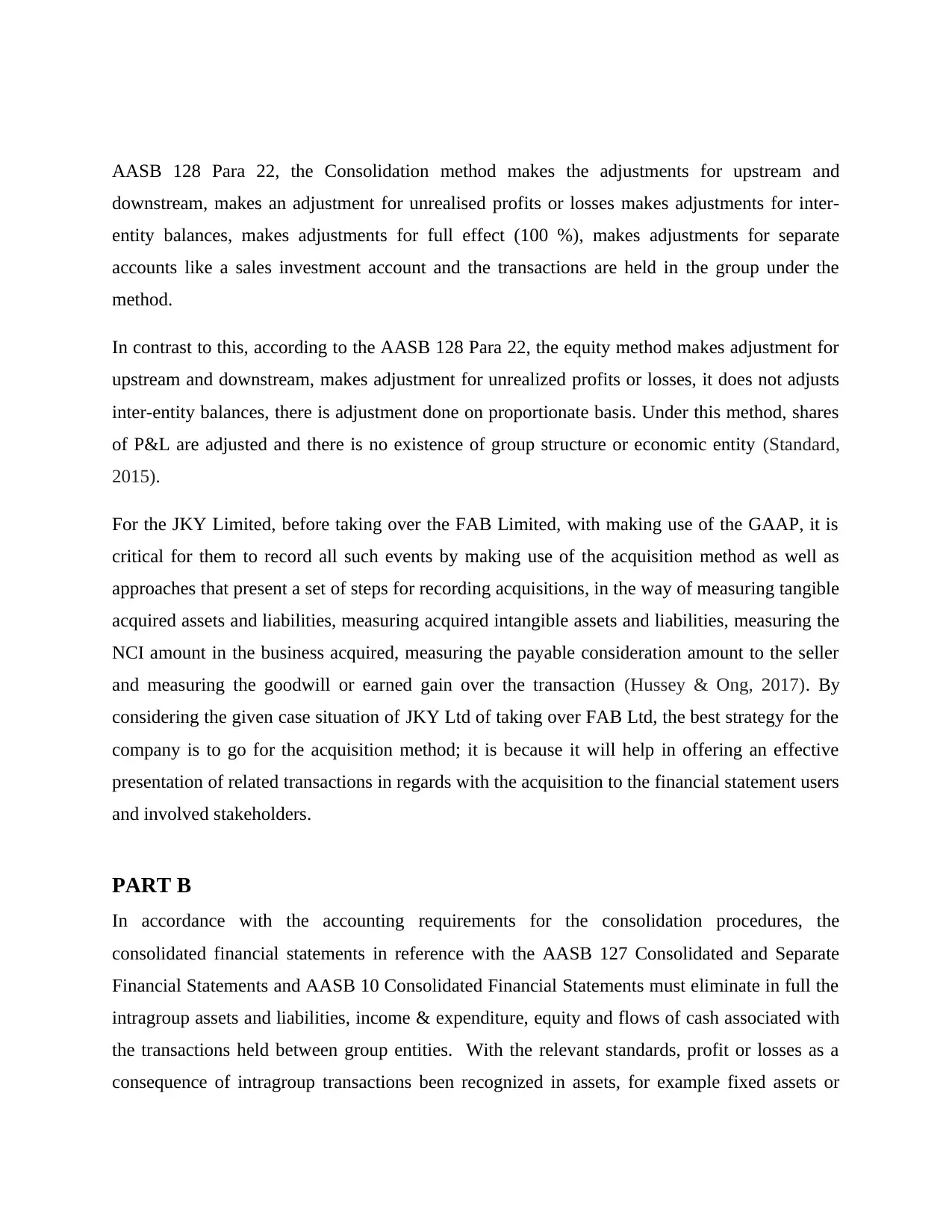
AASB 128 Para 22, the Consolidation method makes the adjustments for upstream and
downstream, makes an adjustment for unrealised profits or losses makes adjustments for inter-
entity balances, makes adjustments for full effect (100 %), makes adjustments for separate
accounts like a sales investment account and the transactions are held in the group under the
method.
In contrast to this, according to the AASB 128 Para 22, the equity method makes adjustment for
upstream and downstream, makes adjustment for unrealized profits or losses, it does not adjusts
inter-entity balances, there is adjustment done on proportionate basis. Under this method, shares
of P&L are adjusted and there is no existence of group structure or economic entity (Standard,
2015).
For the JKY Limited, before taking over the FAB Limited, with making use of the GAAP, it is
critical for them to record all such events by making use of the acquisition method as well as
approaches that present a set of steps for recording acquisitions, in the way of measuring tangible
acquired assets and liabilities, measuring acquired intangible assets and liabilities, measuring the
NCI amount in the business acquired, measuring the payable consideration amount to the seller
and measuring the goodwill or earned gain over the transaction (Hussey & Ong, 2017). By
considering the given case situation of JKY Ltd of taking over FAB Ltd, the best strategy for the
company is to go for the acquisition method; it is because it will help in offering an effective
presentation of related transactions in regards with the acquisition to the financial statement users
and involved stakeholders.
PART B
In accordance with the accounting requirements for the consolidation procedures, the
consolidated financial statements in reference with the AASB 127 Consolidated and Separate
Financial Statements and AASB 10 Consolidated Financial Statements must eliminate in full the
intragroup assets and liabilities, income & expenditure, equity and flows of cash associated with
the transactions held between group entities. With the relevant standards, profit or losses as a
consequence of intragroup transactions been recognized in assets, for example fixed assets or
downstream, makes an adjustment for unrealised profits or losses makes adjustments for inter-
entity balances, makes adjustments for full effect (100 %), makes adjustments for separate
accounts like a sales investment account and the transactions are held in the group under the
method.
In contrast to this, according to the AASB 128 Para 22, the equity method makes adjustment for
upstream and downstream, makes adjustment for unrealized profits or losses, it does not adjusts
inter-entity balances, there is adjustment done on proportionate basis. Under this method, shares
of P&L are adjusted and there is no existence of group structure or economic entity (Standard,
2015).
For the JKY Limited, before taking over the FAB Limited, with making use of the GAAP, it is
critical for them to record all such events by making use of the acquisition method as well as
approaches that present a set of steps for recording acquisitions, in the way of measuring tangible
acquired assets and liabilities, measuring acquired intangible assets and liabilities, measuring the
NCI amount in the business acquired, measuring the payable consideration amount to the seller
and measuring the goodwill or earned gain over the transaction (Hussey & Ong, 2017). By
considering the given case situation of JKY Ltd of taking over FAB Ltd, the best strategy for the
company is to go for the acquisition method; it is because it will help in offering an effective
presentation of related transactions in regards with the acquisition to the financial statement users
and involved stakeholders.
PART B
In accordance with the accounting requirements for the consolidation procedures, the
consolidated financial statements in reference with the AASB 127 Consolidated and Separate
Financial Statements and AASB 10 Consolidated Financial Statements must eliminate in full the
intragroup assets and liabilities, income & expenditure, equity and flows of cash associated with
the transactions held between group entities. With the relevant standards, profit or losses as a
consequence of intragroup transactions been recognized in assets, for example fixed assets or
Secure Best Marks with AI Grader
Need help grading? Try our AI Grader for instant feedback on your assignments.
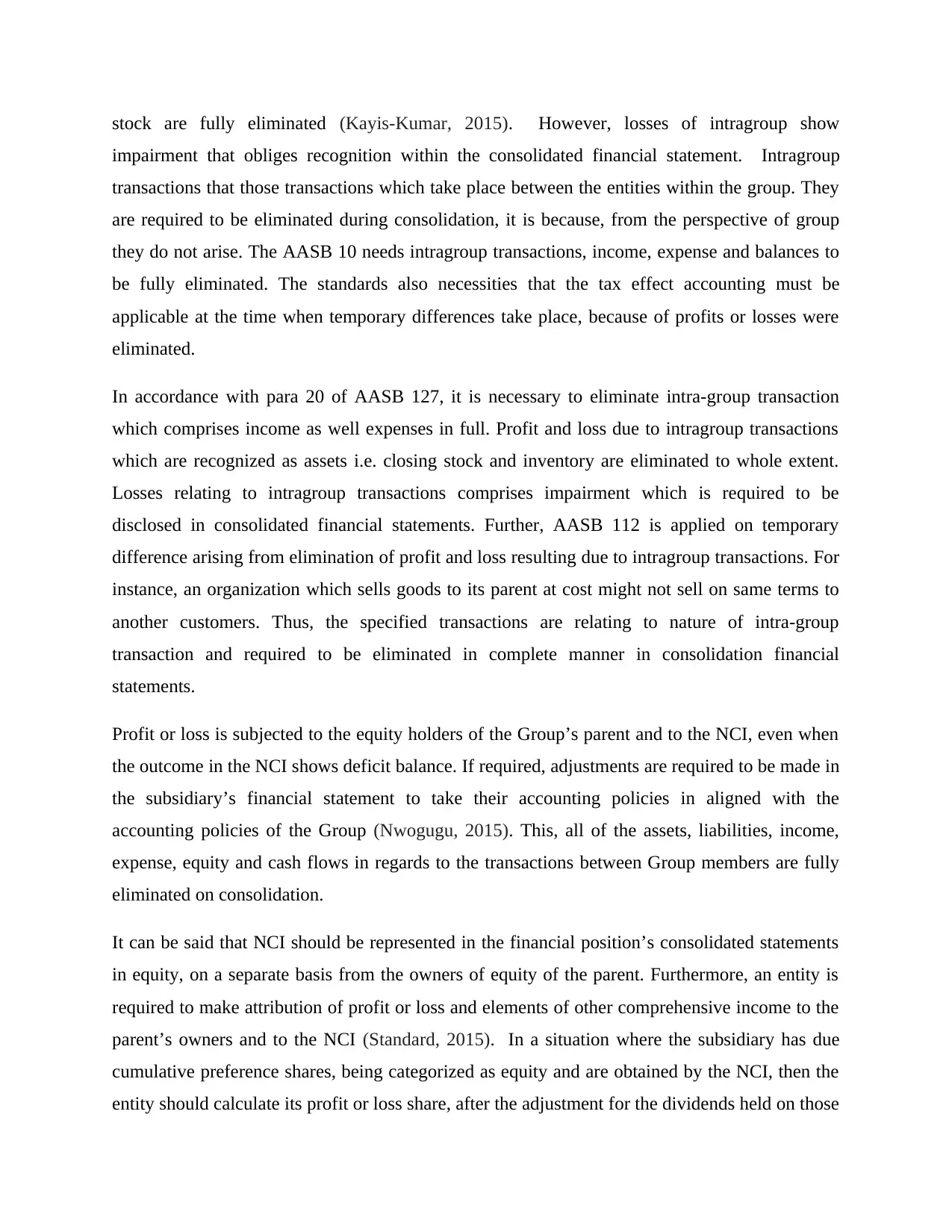
stock are fully eliminated (Kayis-Kumar, 2015). However, losses of intragroup show
impairment that obliges recognition within the consolidated financial statement. Intragroup
transactions that those transactions which take place between the entities within the group. They
are required to be eliminated during consolidation, it is because, from the perspective of group
they do not arise. The AASB 10 needs intragroup transactions, income, expense and balances to
be fully eliminated. The standards also necessities that the tax effect accounting must be
applicable at the time when temporary differences take place, because of profits or losses were
eliminated.
In accordance with para 20 of AASB 127, it is necessary to eliminate intra-group transaction
which comprises income as well expenses in full. Profit and loss due to intragroup transactions
which are recognized as assets i.e. closing stock and inventory are eliminated to whole extent.
Losses relating to intragroup transactions comprises impairment which is required to be
disclosed in consolidated financial statements. Further, AASB 112 is applied on temporary
difference arising from elimination of profit and loss resulting due to intragroup transactions. For
instance, an organization which sells goods to its parent at cost might not sell on same terms to
another customers. Thus, the specified transactions are relating to nature of intra-group
transaction and required to be eliminated in complete manner in consolidation financial
statements.
Profit or loss is subjected to the equity holders of the Group’s parent and to the NCI, even when
the outcome in the NCI shows deficit balance. If required, adjustments are required to be made in
the subsidiary’s financial statement to take their accounting policies in aligned with the
accounting policies of the Group (Nwogugu, 2015). This, all of the assets, liabilities, income,
expense, equity and cash flows in regards to the transactions between Group members are fully
eliminated on consolidation.
It can be said that NCI should be represented in the financial position’s consolidated statements
in equity, on a separate basis from the owners of equity of the parent. Furthermore, an entity is
required to make attribution of profit or loss and elements of other comprehensive income to the
parent’s owners and to the NCI (Standard, 2015). In a situation where the subsidiary has due
cumulative preference shares, being categorized as equity and are obtained by the NCI, then the
entity should calculate its profit or loss share, after the adjustment for the dividends held on those
impairment that obliges recognition within the consolidated financial statement. Intragroup
transactions that those transactions which take place between the entities within the group. They
are required to be eliminated during consolidation, it is because, from the perspective of group
they do not arise. The AASB 10 needs intragroup transactions, income, expense and balances to
be fully eliminated. The standards also necessities that the tax effect accounting must be
applicable at the time when temporary differences take place, because of profits or losses were
eliminated.
In accordance with para 20 of AASB 127, it is necessary to eliminate intra-group transaction
which comprises income as well expenses in full. Profit and loss due to intragroup transactions
which are recognized as assets i.e. closing stock and inventory are eliminated to whole extent.
Losses relating to intragroup transactions comprises impairment which is required to be
disclosed in consolidated financial statements. Further, AASB 112 is applied on temporary
difference arising from elimination of profit and loss resulting due to intragroup transactions. For
instance, an organization which sells goods to its parent at cost might not sell on same terms to
another customers. Thus, the specified transactions are relating to nature of intra-group
transaction and required to be eliminated in complete manner in consolidation financial
statements.
Profit or loss is subjected to the equity holders of the Group’s parent and to the NCI, even when
the outcome in the NCI shows deficit balance. If required, adjustments are required to be made in
the subsidiary’s financial statement to take their accounting policies in aligned with the
accounting policies of the Group (Nwogugu, 2015). This, all of the assets, liabilities, income,
expense, equity and cash flows in regards to the transactions between Group members are fully
eliminated on consolidation.
It can be said that NCI should be represented in the financial position’s consolidated statements
in equity, on a separate basis from the owners of equity of the parent. Furthermore, an entity is
required to make attribution of profit or loss and elements of other comprehensive income to the
parent’s owners and to the NCI (Standard, 2015). In a situation where the subsidiary has due
cumulative preference shares, being categorized as equity and are obtained by the NCI, then the
entity should calculate its profit or loss share, after the adjustment for the dividends held on those
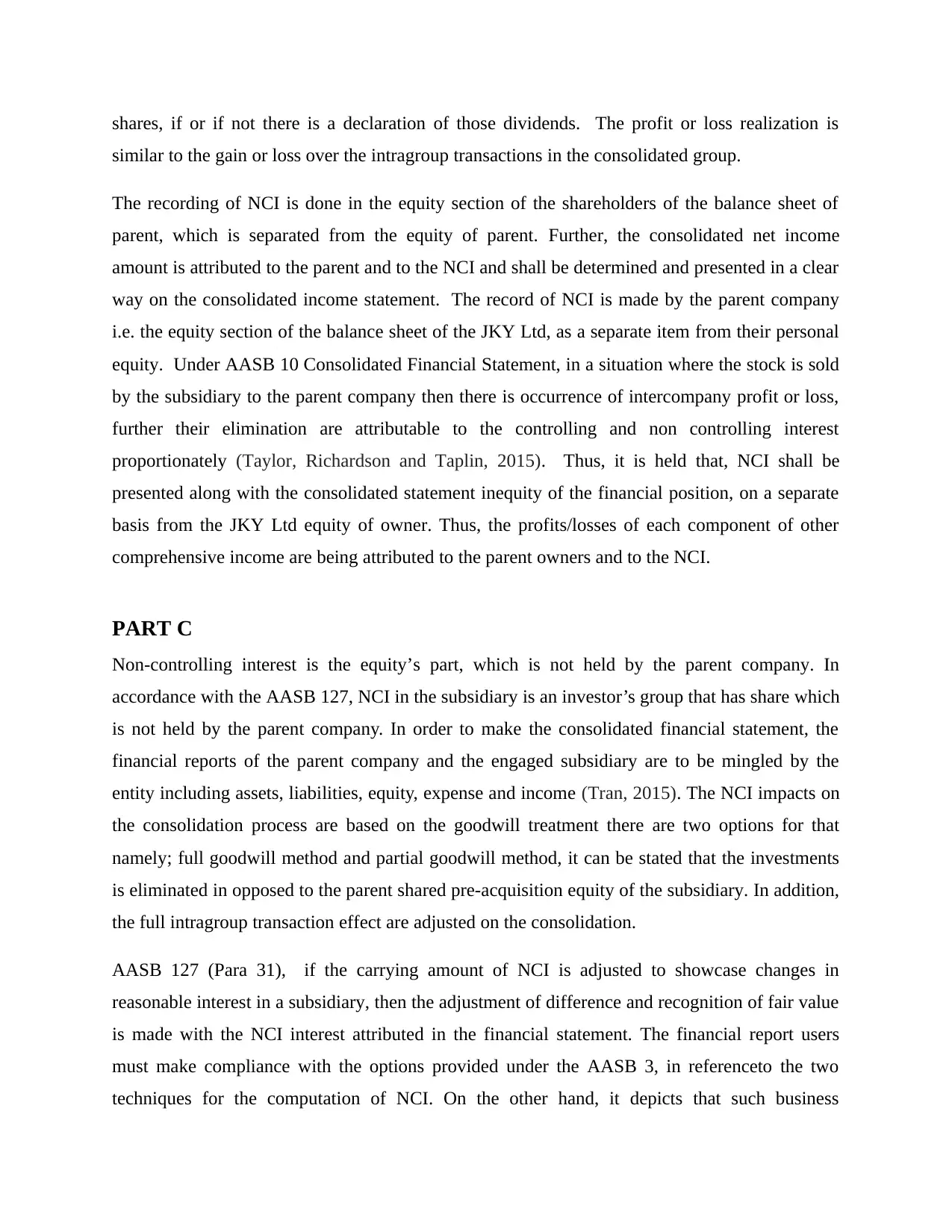
shares, if or if not there is a declaration of those dividends. The profit or loss realization is
similar to the gain or loss over the intragroup transactions in the consolidated group.
The recording of NCI is done in the equity section of the shareholders of the balance sheet of
parent, which is separated from the equity of parent. Further, the consolidated net income
amount is attributed to the parent and to the NCI and shall be determined and presented in a clear
way on the consolidated income statement. The record of NCI is made by the parent company
i.e. the equity section of the balance sheet of the JKY Ltd, as a separate item from their personal
equity. Under AASB 10 Consolidated Financial Statement, in a situation where the stock is sold
by the subsidiary to the parent company then there is occurrence of intercompany profit or loss,
further their elimination are attributable to the controlling and non controlling interest
proportionately (Taylor, Richardson and Taplin, 2015). Thus, it is held that, NCI shall be
presented along with the consolidated statement inequity of the financial position, on a separate
basis from the JKY Ltd equity of owner. Thus, the profits/losses of each component of other
comprehensive income are being attributed to the parent owners and to the NCI.
PART C
Non-controlling interest is the equity’s part, which is not held by the parent company. In
accordance with the AASB 127, NCI in the subsidiary is an investor’s group that has share which
is not held by the parent company. In order to make the consolidated financial statement, the
financial reports of the parent company and the engaged subsidiary are to be mingled by the
entity including assets, liabilities, equity, expense and income (Tran, 2015). The NCI impacts on
the consolidation process are based on the goodwill treatment there are two options for that
namely; full goodwill method and partial goodwill method, it can be stated that the investments
is eliminated in opposed to the parent shared pre-acquisition equity of the subsidiary. In addition,
the full intragroup transaction effect are adjusted on the consolidation.
AASB 127 (Para 31), if the carrying amount of NCI is adjusted to showcase changes in
reasonable interest in a subsidiary, then the adjustment of difference and recognition of fair value
is made with the NCI interest attributed in the financial statement. The financial report users
must make compliance with the options provided under the AASB 3, in referenceto the two
techniques for the computation of NCI. On the other hand, it depicts that such business
similar to the gain or loss over the intragroup transactions in the consolidated group.
The recording of NCI is done in the equity section of the shareholders of the balance sheet of
parent, which is separated from the equity of parent. Further, the consolidated net income
amount is attributed to the parent and to the NCI and shall be determined and presented in a clear
way on the consolidated income statement. The record of NCI is made by the parent company
i.e. the equity section of the balance sheet of the JKY Ltd, as a separate item from their personal
equity. Under AASB 10 Consolidated Financial Statement, in a situation where the stock is sold
by the subsidiary to the parent company then there is occurrence of intercompany profit or loss,
further their elimination are attributable to the controlling and non controlling interest
proportionately (Taylor, Richardson and Taplin, 2015). Thus, it is held that, NCI shall be
presented along with the consolidated statement inequity of the financial position, on a separate
basis from the JKY Ltd equity of owner. Thus, the profits/losses of each component of other
comprehensive income are being attributed to the parent owners and to the NCI.
PART C
Non-controlling interest is the equity’s part, which is not held by the parent company. In
accordance with the AASB 127, NCI in the subsidiary is an investor’s group that has share which
is not held by the parent company. In order to make the consolidated financial statement, the
financial reports of the parent company and the engaged subsidiary are to be mingled by the
entity including assets, liabilities, equity, expense and income (Tran, 2015). The NCI impacts on
the consolidation process are based on the goodwill treatment there are two options for that
namely; full goodwill method and partial goodwill method, it can be stated that the investments
is eliminated in opposed to the parent shared pre-acquisition equity of the subsidiary. In addition,
the full intragroup transaction effect are adjusted on the consolidation.
AASB 127 (Para 31), if the carrying amount of NCI is adjusted to showcase changes in
reasonable interest in a subsidiary, then the adjustment of difference and recognition of fair value
is made with the NCI interest attributed in the financial statement. The financial report users
must make compliance with the options provided under the AASB 3, in referenceto the two
techniques for the computation of NCI. On the other hand, it depicts that such business
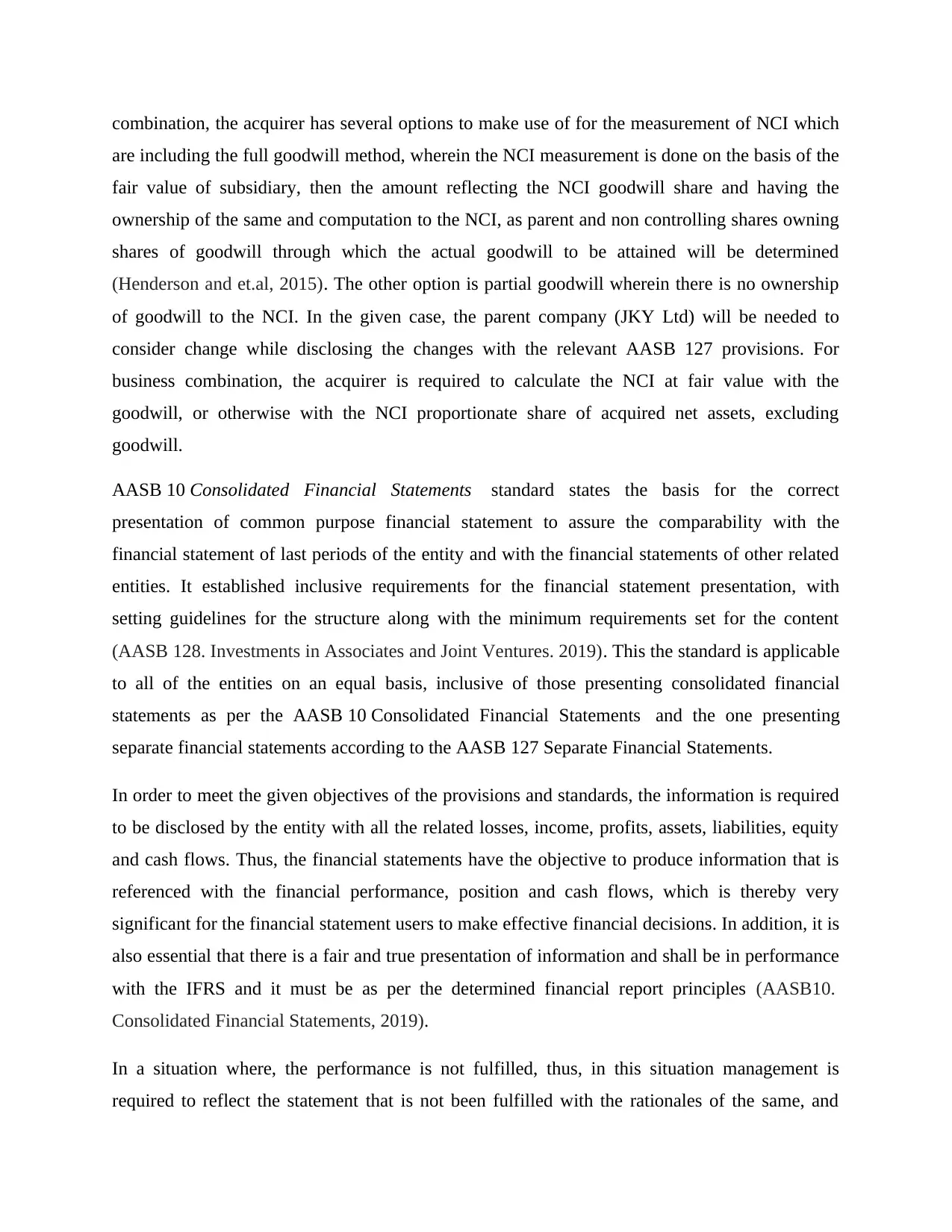
combination, the acquirer has several options to make use of for the measurement of NCI which
are including the full goodwill method, wherein the NCI measurement is done on the basis of the
fair value of subsidiary, then the amount reflecting the NCI goodwill share and having the
ownership of the same and computation to the NCI, as parent and non controlling shares owning
shares of goodwill through which the actual goodwill to be attained will be determined
(Henderson and et.al, 2015). The other option is partial goodwill wherein there is no ownership
of goodwill to the NCI. In the given case, the parent company (JKY Ltd) will be needed to
consider change while disclosing the changes with the relevant AASB 127 provisions. For
business combination, the acquirer is required to calculate the NCI at fair value with the
goodwill, or otherwise with the NCI proportionate share of acquired net assets, excluding
goodwill.
AASB 10 Consolidated Financial Statements standard states the basis for the correct
presentation of common purpose financial statement to assure the comparability with the
financial statement of last periods of the entity and with the financial statements of other related
entities. It established inclusive requirements for the financial statement presentation, with
setting guidelines for the structure along with the minimum requirements set for the content
(AASB 128. Investments in Associates and Joint Ventures. 2019). This the standard is applicable
to all of the entities on an equal basis, inclusive of those presenting consolidated financial
statements as per the AASB 10 Consolidated Financial Statements and the one presenting
separate financial statements according to the AASB 127 Separate Financial Statements.
In order to meet the given objectives of the provisions and standards, the information is required
to be disclosed by the entity with all the related losses, income, profits, assets, liabilities, equity
and cash flows. Thus, the financial statements have the objective to produce information that is
referenced with the financial performance, position and cash flows, which is thereby very
significant for the financial statement users to make effective financial decisions. In addition, it is
also essential that there is a fair and true presentation of information and shall be in performance
with the IFRS and it must be as per the determined financial report principles (AASB10.
Consolidated Financial Statements, 2019).
In a situation where, the performance is not fulfilled, thus, in this situation management is
required to reflect the statement that is not been fulfilled with the rationales of the same, and
are including the full goodwill method, wherein the NCI measurement is done on the basis of the
fair value of subsidiary, then the amount reflecting the NCI goodwill share and having the
ownership of the same and computation to the NCI, as parent and non controlling shares owning
shares of goodwill through which the actual goodwill to be attained will be determined
(Henderson and et.al, 2015). The other option is partial goodwill wherein there is no ownership
of goodwill to the NCI. In the given case, the parent company (JKY Ltd) will be needed to
consider change while disclosing the changes with the relevant AASB 127 provisions. For
business combination, the acquirer is required to calculate the NCI at fair value with the
goodwill, or otherwise with the NCI proportionate share of acquired net assets, excluding
goodwill.
AASB 10 Consolidated Financial Statements standard states the basis for the correct
presentation of common purpose financial statement to assure the comparability with the
financial statement of last periods of the entity and with the financial statements of other related
entities. It established inclusive requirements for the financial statement presentation, with
setting guidelines for the structure along with the minimum requirements set for the content
(AASB 128. Investments in Associates and Joint Ventures. 2019). This the standard is applicable
to all of the entities on an equal basis, inclusive of those presenting consolidated financial
statements as per the AASB 10 Consolidated Financial Statements and the one presenting
separate financial statements according to the AASB 127 Separate Financial Statements.
In order to meet the given objectives of the provisions and standards, the information is required
to be disclosed by the entity with all the related losses, income, profits, assets, liabilities, equity
and cash flows. Thus, the financial statements have the objective to produce information that is
referenced with the financial performance, position and cash flows, which is thereby very
significant for the financial statement users to make effective financial decisions. In addition, it is
also essential that there is a fair and true presentation of information and shall be in performance
with the IFRS and it must be as per the determined financial report principles (AASB10.
Consolidated Financial Statements, 2019).
In a situation where, the performance is not fulfilled, thus, in this situation management is
required to reflect the statement that is not been fulfilled with the rationales of the same, and
Paraphrase This Document
Need a fresh take? Get an instant paraphrase of this document with our AI Paraphraser
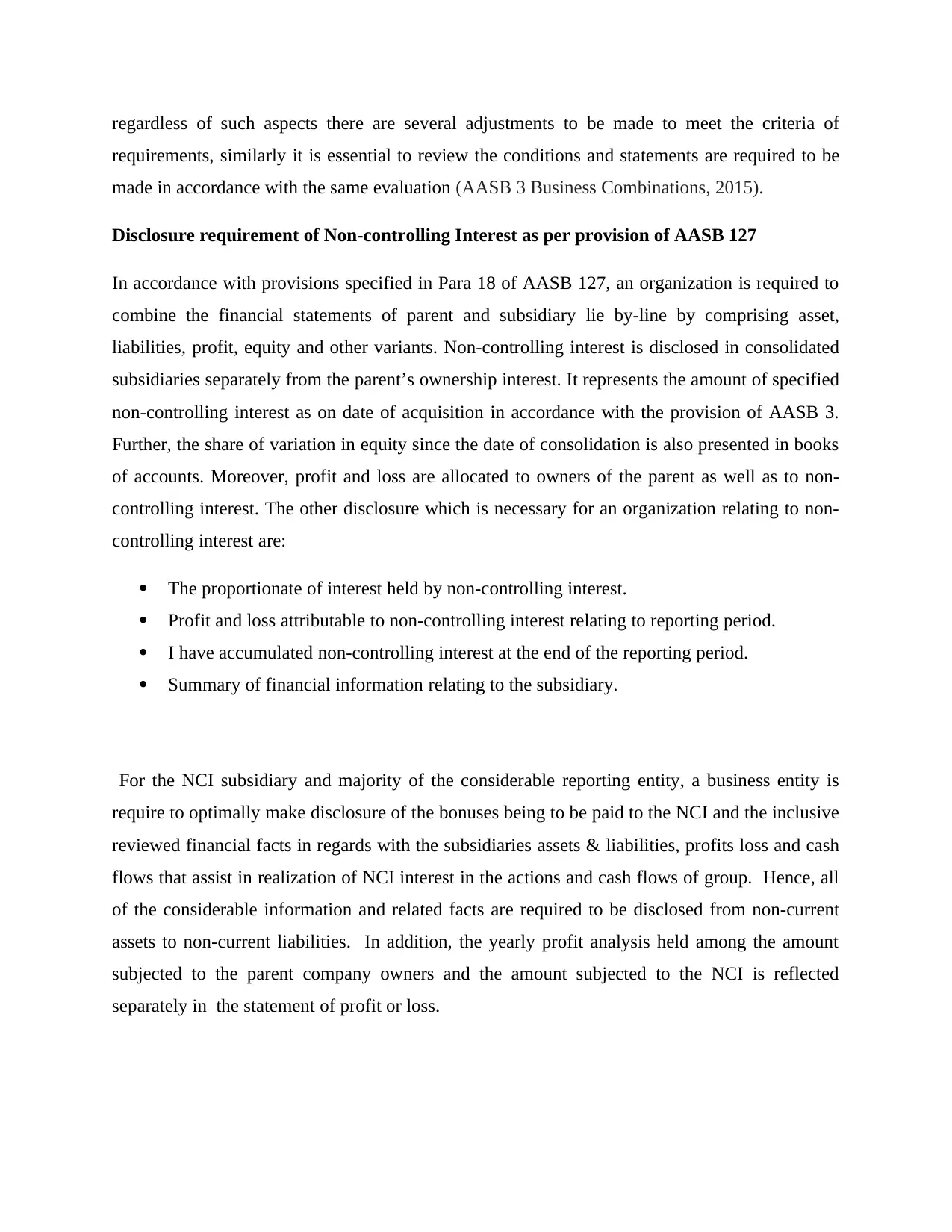
regardless of such aspects there are several adjustments to be made to meet the criteria of
requirements, similarly it is essential to review the conditions and statements are required to be
made in accordance with the same evaluation (AASB 3 Business Combinations, 2015).
Disclosure requirement of Non-controlling Interest as per provision of AASB 127
In accordance with provisions specified in Para 18 of AASB 127, an organization is required to
combine the financial statements of parent and subsidiary lie by-line by comprising asset,
liabilities, profit, equity and other variants. Non-controlling interest is disclosed in consolidated
subsidiaries separately from the parent’s ownership interest. It represents the amount of specified
non-controlling interest as on date of acquisition in accordance with the provision of AASB 3.
Further, the share of variation in equity since the date of consolidation is also presented in books
of accounts. Moreover, profit and loss are allocated to owners of the parent as well as to non-
controlling interest. The other disclosure which is necessary for an organization relating to non-
controlling interest are:
The proportionate of interest held by non-controlling interest.
Profit and loss attributable to non-controlling interest relating to reporting period.
I have accumulated non-controlling interest at the end of the reporting period.
Summary of financial information relating to the subsidiary.
For the NCI subsidiary and majority of the considerable reporting entity, a business entity is
require to optimally make disclosure of the bonuses being to be paid to the NCI and the inclusive
reviewed financial facts in regards with the subsidiaries assets & liabilities, profits loss and cash
flows that assist in realization of NCI interest in the actions and cash flows of group. Hence, all
of the considerable information and related facts are required to be disclosed from non-current
assets to non-current liabilities. In addition, the yearly profit analysis held among the amount
subjected to the parent company owners and the amount subjected to the NCI is reflected
separately in the statement of profit or loss.
requirements, similarly it is essential to review the conditions and statements are required to be
made in accordance with the same evaluation (AASB 3 Business Combinations, 2015).
Disclosure requirement of Non-controlling Interest as per provision of AASB 127
In accordance with provisions specified in Para 18 of AASB 127, an organization is required to
combine the financial statements of parent and subsidiary lie by-line by comprising asset,
liabilities, profit, equity and other variants. Non-controlling interest is disclosed in consolidated
subsidiaries separately from the parent’s ownership interest. It represents the amount of specified
non-controlling interest as on date of acquisition in accordance with the provision of AASB 3.
Further, the share of variation in equity since the date of consolidation is also presented in books
of accounts. Moreover, profit and loss are allocated to owners of the parent as well as to non-
controlling interest. The other disclosure which is necessary for an organization relating to non-
controlling interest are:
The proportionate of interest held by non-controlling interest.
Profit and loss attributable to non-controlling interest relating to reporting period.
I have accumulated non-controlling interest at the end of the reporting period.
Summary of financial information relating to the subsidiary.
For the NCI subsidiary and majority of the considerable reporting entity, a business entity is
require to optimally make disclosure of the bonuses being to be paid to the NCI and the inclusive
reviewed financial facts in regards with the subsidiaries assets & liabilities, profits loss and cash
flows that assist in realization of NCI interest in the actions and cash flows of group. Hence, all
of the considerable information and related facts are required to be disclosed from non-current
assets to non-current liabilities. In addition, the yearly profit analysis held among the amount
subjected to the parent company owners and the amount subjected to the NCI is reflected
separately in the statement of profit or loss.
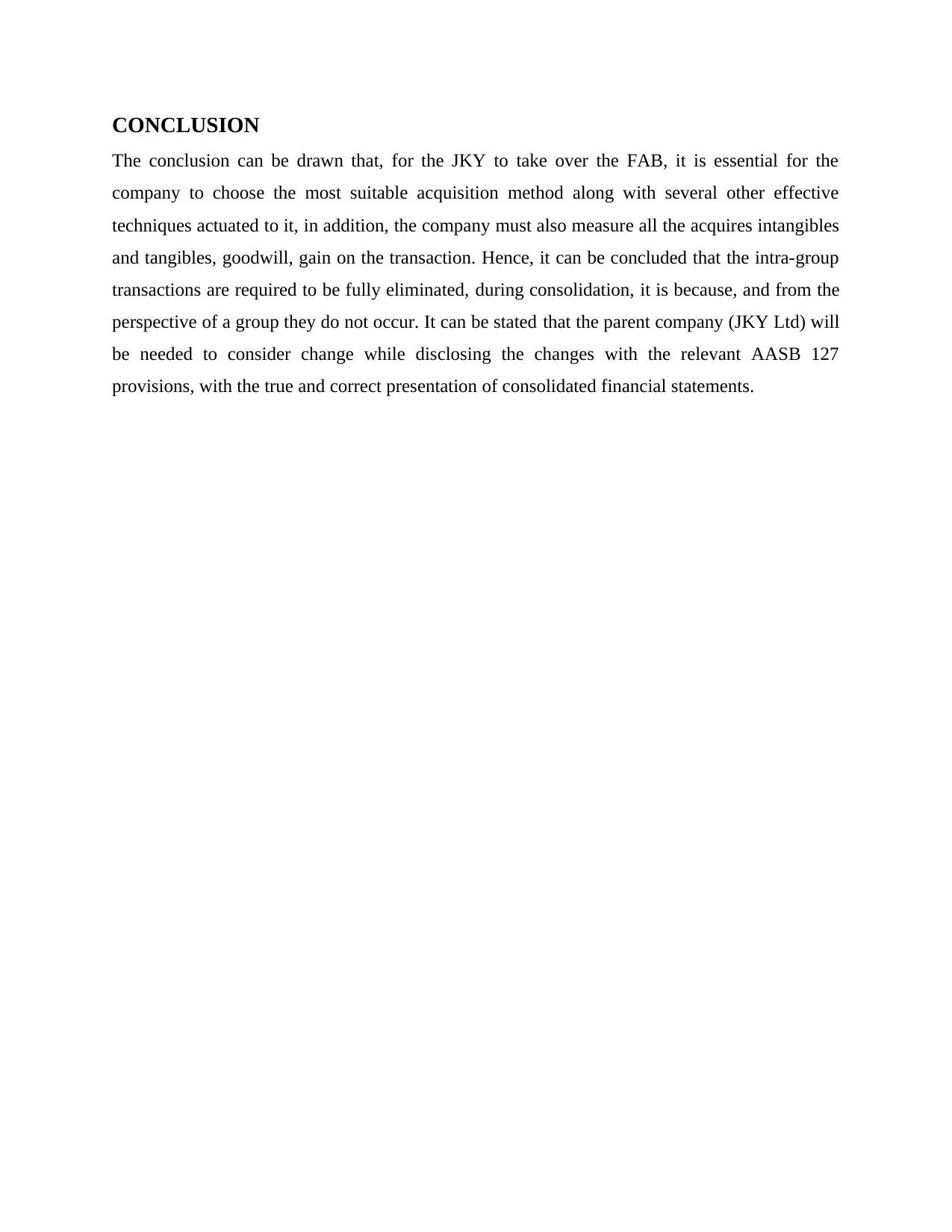
CONCLUSION
The conclusion can be drawn that, for the JKY to take over the FAB, it is essential for the
company to choose the most suitable acquisition method along with several other effective
techniques actuated to it, in addition, the company must also measure all the acquires intangibles
and tangibles, goodwill, gain on the transaction. Hence, it can be concluded that the intra-group
transactions are required to be fully eliminated, during consolidation, it is because, and from the
perspective of a group they do not occur. It can be stated that the parent company (JKY Ltd) will
be needed to consider change while disclosing the changes with the relevant AASB 127
provisions, with the true and correct presentation of consolidated financial statements.
The conclusion can be drawn that, for the JKY to take over the FAB, it is essential for the
company to choose the most suitable acquisition method along with several other effective
techniques actuated to it, in addition, the company must also measure all the acquires intangibles
and tangibles, goodwill, gain on the transaction. Hence, it can be concluded that the intra-group
transactions are required to be fully eliminated, during consolidation, it is because, and from the
perspective of a group they do not occur. It can be stated that the parent company (JKY Ltd) will
be needed to consider change while disclosing the changes with the relevant AASB 127
provisions, with the true and correct presentation of consolidated financial statements.
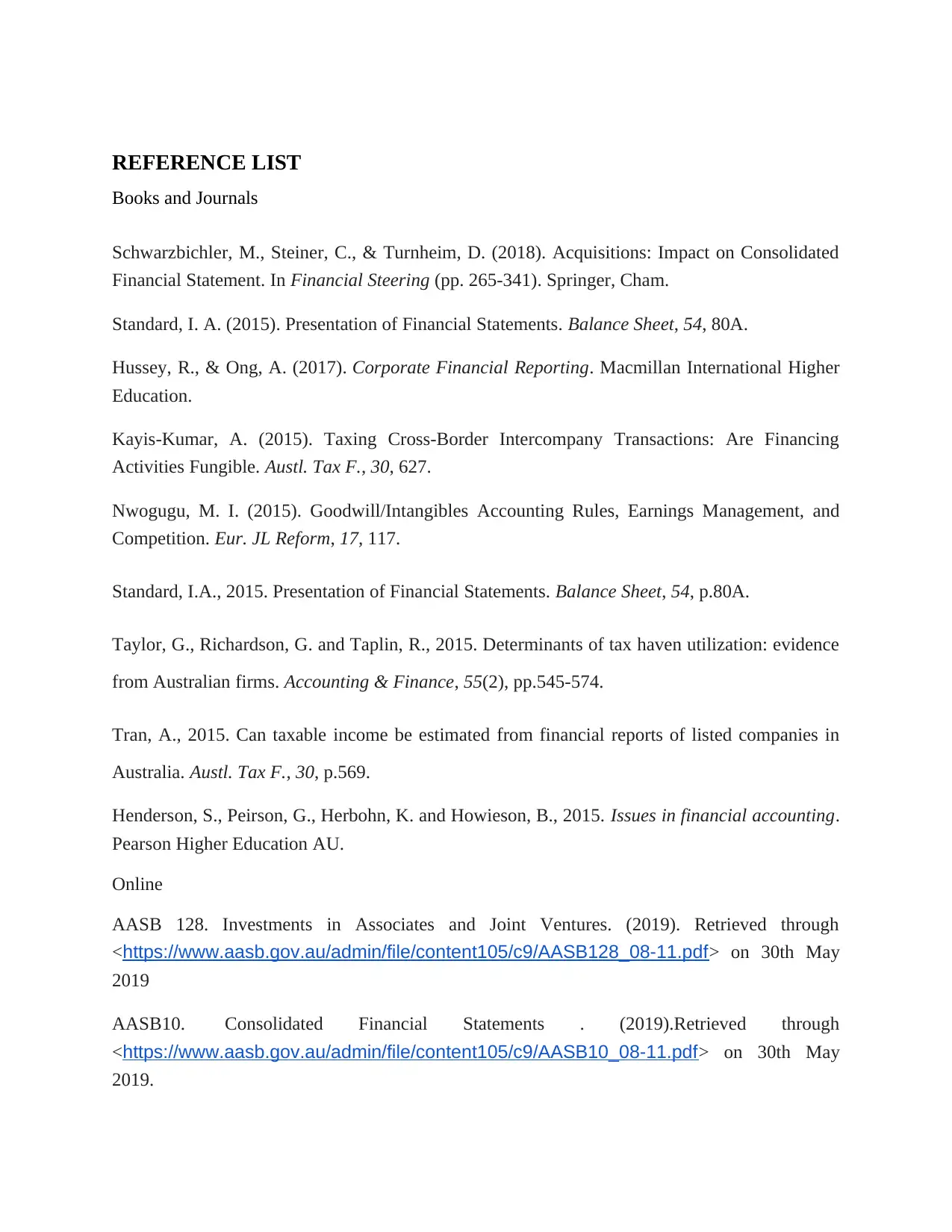
REFERENCE LIST
Books and Journals
Schwarzbichler, M., Steiner, C., & Turnheim, D. (2018). Acquisitions: Impact on Consolidated
Financial Statement. In Financial Steering (pp. 265-341). Springer, Cham.
Standard, I. A. (2015). Presentation of Financial Statements. Balance Sheet, 54, 80A.
Hussey, R., & Ong, A. (2017). Corporate Financial Reporting. Macmillan International Higher
Education.
Kayis-Kumar, A. (2015). Taxing Cross-Border Intercompany Transactions: Are Financing
Activities Fungible. Austl. Tax F., 30, 627.
Nwogugu, M. I. (2015). Goodwill/Intangibles Accounting Rules, Earnings Management, and
Competition. Eur. JL Reform, 17, 117.
Standard, I.A., 2015. Presentation of Financial Statements. Balance Sheet, 54, p.80A.
Taylor, G., Richardson, G. and Taplin, R., 2015. Determinants of tax haven utilization: evidence
from Australian firms. Accounting & Finance, 55(2), pp.545-574.
Tran, A., 2015. Can taxable income be estimated from financial reports of listed companies in
Australia. Austl. Tax F., 30, p.569.
Henderson, S., Peirson, G., Herbohn, K. and Howieson, B., 2015. Issues in financial accounting.
Pearson Higher Education AU.
Online
AASB 128. Investments in Associates and Joint Ventures. (2019). Retrieved through
<https://www.aasb.gov.au/admin/file/content105/c9/AASB128_08-11.pdf> on 30th May
2019
AASB10. Consolidated Financial Statements . (2019).Retrieved through
<https://www.aasb.gov.au/admin/file/content105/c9/AASB10_08-11.pdf> on 30th May
2019.
Books and Journals
Schwarzbichler, M., Steiner, C., & Turnheim, D. (2018). Acquisitions: Impact on Consolidated
Financial Statement. In Financial Steering (pp. 265-341). Springer, Cham.
Standard, I. A. (2015). Presentation of Financial Statements. Balance Sheet, 54, 80A.
Hussey, R., & Ong, A. (2017). Corporate Financial Reporting. Macmillan International Higher
Education.
Kayis-Kumar, A. (2015). Taxing Cross-Border Intercompany Transactions: Are Financing
Activities Fungible. Austl. Tax F., 30, 627.
Nwogugu, M. I. (2015). Goodwill/Intangibles Accounting Rules, Earnings Management, and
Competition. Eur. JL Reform, 17, 117.
Standard, I.A., 2015. Presentation of Financial Statements. Balance Sheet, 54, p.80A.
Taylor, G., Richardson, G. and Taplin, R., 2015. Determinants of tax haven utilization: evidence
from Australian firms. Accounting & Finance, 55(2), pp.545-574.
Tran, A., 2015. Can taxable income be estimated from financial reports of listed companies in
Australia. Austl. Tax F., 30, p.569.
Henderson, S., Peirson, G., Herbohn, K. and Howieson, B., 2015. Issues in financial accounting.
Pearson Higher Education AU.
Online
AASB 128. Investments in Associates and Joint Ventures. (2019). Retrieved through
<https://www.aasb.gov.au/admin/file/content105/c9/AASB128_08-11.pdf> on 30th May
2019
AASB10. Consolidated Financial Statements . (2019).Retrieved through
<https://www.aasb.gov.au/admin/file/content105/c9/AASB10_08-11.pdf> on 30th May
2019.
Secure Best Marks with AI Grader
Need help grading? Try our AI Grader for instant feedback on your assignments.

AASB 3 Business Combinations . (2015). Retrieved through
<https://www.aasb.gov.au/admin/file/content105/c9/AASB3_08-15.pdf> on 30th May
2019
<https://www.aasb.gov.au/admin/file/content105/c9/AASB3_08-15.pdf> on 30th May
2019
1 out of 11
Related Documents
Your All-in-One AI-Powered Toolkit for Academic Success.
+13062052269
info@desklib.com
Available 24*7 on WhatsApp / Email
![[object Object]](/_next/static/media/star-bottom.7253800d.svg)
Unlock your academic potential
© 2024 | Zucol Services PVT LTD | All rights reserved.




